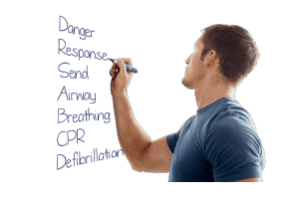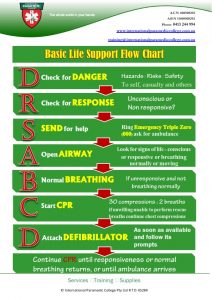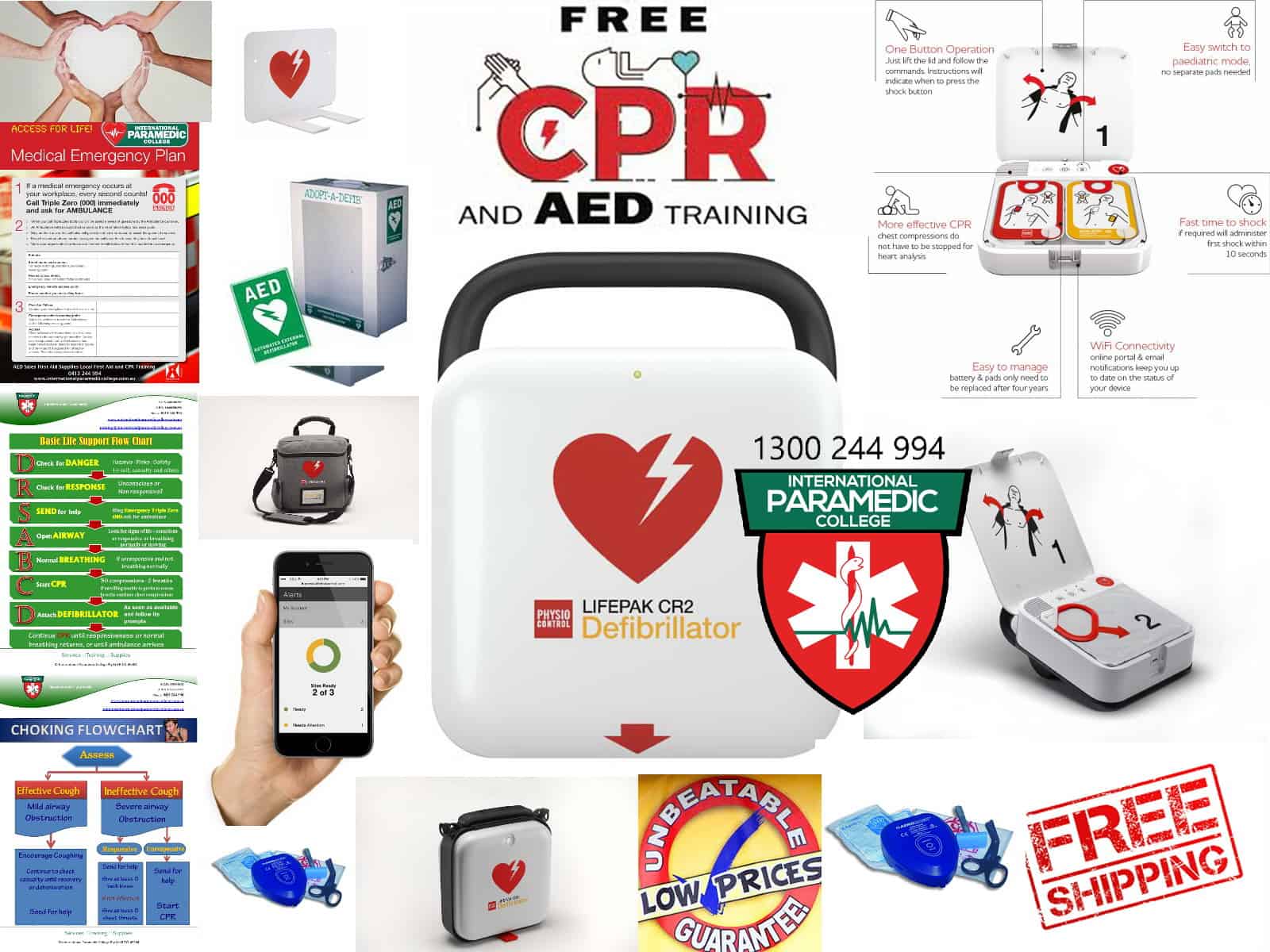DRSABCD of First Aid
What does DRSABCD mean in First Aid and CPR Courses?
DRSABCD is an acronym described as an Emergency action plan for first aiders or first responders to an emergency.
So what does DRS ABCD stand for?
Danger (Check for danger to yourself patient and others patient)
Response (to check the patients response to see if a patient is conscious or unconscious)
Send for help (call 000 if needed)
Airway (check and clear obstructions to the airway)
Breathing (check if patient is breathing normally or not)
CPR (commence CPR if necessary)
Defibrillation ( If CPR is needed than an AED is needed)
Practical ways to apply the DRSABC action plan and what to do until the ambulance arrives are part of our First aid and CPR courses risk factors of heart attack, click on this link
If it’s a heart attack it’s dirty plumbing, if it’s a Sudden Cardiac Arrest (SCA) it’s an electrical problem?
Yes, your heart beats/pumps blood through your body because it is told to squeeze by electrical currents that travel through your heart. These electrical currents have a specific pathway and pattern. When something goes wrong with this electrical pathway/current it can make your heart beat in a way that stops the heart from pumping properly, this means that your heart, brain and other vital organs aren’t getting the blood they need to function. Action to correct this is best done by bystanders with an AED.
If a sudden cardiac arrest occurs the person will become unconscious and will stop breathing or stop breathing normally. While CPR keeps blood moving around the body, especially to the brain, it cannot reverse the electrical problem it needs to be treated with a defibrillator or AED to stop the chaotic electrical activity in the hope that a normal electrical mechanical response will be restored.
Call the Ambulance on 000 in Australia for sudden cardiac arrest. Start CPR and ensure you have a Defibrillator
Download your free wall chart here of the DRSABCD Emergency action plan
Any chest pain should be considered a heart attack until proven otherwise at hospital.
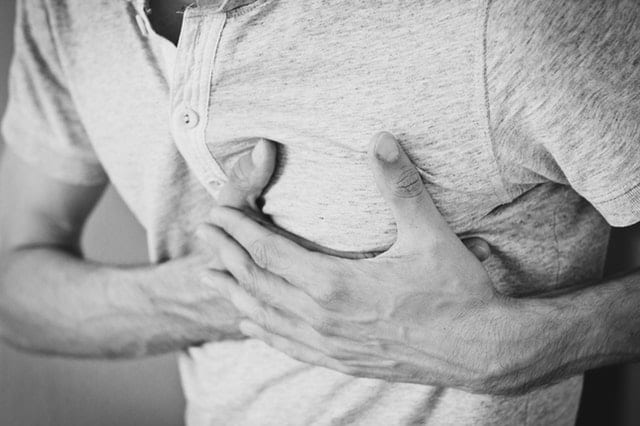
“Chest pain can be classified as any pain or discomfort to an area around the chest. Chest pain may be caused by a multitude of disease processes or injuries to the chest, lungs, heart, diaphragm, neck, stomach (reflux/indigestion pain) and even the abdominal organs. Paramedics and hospitals will If in doubt about the type of chest pain, look for or rule out potential cardiac causes.”
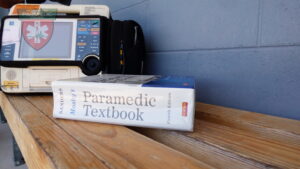 Paramedical EMT Medic & First Responder courses
Paramedical EMT Medic & First Responder courses
Most of the units can be delivered 100% online. Short practical time frames in all metropolitan cities and some regional areas of Australia. Live webinars with real paramedics where you can Q&A what you need to learn. The practical components can be done via video or online meetings at set times. We can also deliver our scope of courses by face-to-face methods. We have a number of flexible mixed mode delivery options and pathways training. Our unique learning systems use industry reference textbooks. Australian textbooks like the Principals of paramedic practice and paramedic skills manual textbooks are used to support and focus your learning via industry standards. Our curriculum is unique, written by us, not some generic health content, it is focused on teaching you relevant and real paramedic skills.
We have a unique paramedical pathway educational program where you can journey through our medic and paramedical education units on your way to becoming a paramedic, so it takes no extra time but gives you the advantage of low upfront costs, a taste of what the career might be like and gets you qualifications such as the
Certificate II in Medical Service First Response
Certificate III in Basic Health Care
Certificate lll in Non-Emergency Patient Transport (NEPT)
Certificate IV in Health Care (Medic Ambulance EMT First Responder)
Diploma of Emergency Health Care (Paramedical pre-hospital care training)
You can work your way through the qualifications in our unique pathways approach which costs you no more money or time, saves you upfront costs and gives you qualifications along the way to the Diploma of Emergency Health Care and use that to gain entry to employment or for advanced standing or RPL for University study to the Bachelor’s Degree in Paramedic Practice. Each University in Australia has programs to recognise prior learning and studies.
RPL - RCC - Credit Transfer
Fixed Pricing for RPL RCC - Certificate Qualifications
Emergency Medic - Paramedical -
EMT - First Responder
We are the pre-hospital care experts on RPL RCC in Australia
- Cert II RPL Fixed Pricing
- Cert III RPL Fixed Pricing
- Cert III NEPT RPL Fixed Pricing
- Cert IV RPL Fixed Pricing
- Diploma RPL Fixed Pricing
HLT21020 Certificate II in Medical Service First Response
$650 Fixed Price RPL / RCC
We will book a zoom session with you to discuss your application and let you know if it is possible to get RPL with your current evidence and what evidence would be required in your case, prior to payment of any fees
If your evidence is insufficient for a grant of RPL you may complete gap training at a discounted price
You will be required to have a current first aid certificate (HLTAID011)
HLT31220 – Certificate III in Basic Health Care
$750 Fixed Price RPL / RCC
We will book a zoom session with you to discuss your application and let you know if it is possible to get RPL with your current evidence and what evidence would be required in your case, prior to payment of any fees
If your evidence is insufficient for a grant of RPL you may complete gap training at a discounted price
You will be required to have a current first aid certificate (HLTAID011)
HLT31120 Certificate III in Non-Emergency Patient Transport
$850 Fixed Price RPL / RCC
We will book a zoom session with you to discuss your application and let you know if it is possible to get RPL with your current evidence and what evidence would be required in your case, prior to payment of any fees
If your evidence is insufficient for a grant of RPL you may complete gap training at a discounted price
You will be required to have a current first aid certificate (HLTAID011)
HLT41120 Certificate IV in Health Care (First responder EMT Medic)
Ambulance EMT Medic Course
$1250 Fixed Price RPL / RCC
We will book a zoom session with you to discuss your application and let you know if it is possible to get RPL with your current evidence and what evidence would be required in your case, prior to payment of any fees
If your evidence is insufficient for a grant of RPL you may complete gap training at a discounted price
HLT51020 Diploma of Emergency Health Care (Paramedical Training)
$1995 Fixed Price RPL / RCC
We will book a zoom session with you to discuss your application and let you know if it is possible to get RPL with your current evidence and what evidence would be required in your case, prior to payment of any fees
If your evidence is insufficient for a grant of RPL you may complete gap training at a discounted price

